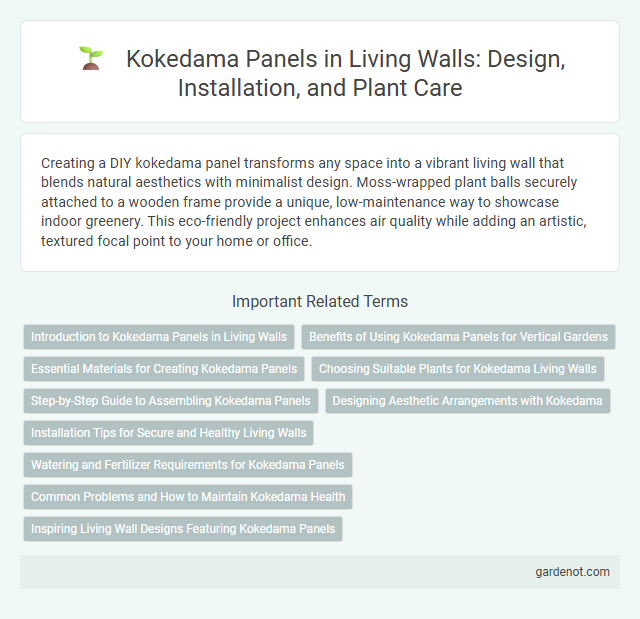Creating a DIY kokedama panel transforms any space into a vibrant living wall that blends natural aesthetics with minimalist design. Moss-wrapped plant balls securely attached to a wooden frame provide a unique, low-maintenance way to showcase indoor greenery. This eco-friendly project enhances air quality while adding an artistic, textured focal point to your home or office.
Introduction to Kokedama Panels in Living Walls
Kokedama panels are an innovative approach to living walls, combining traditional Japanese moss ball planting with vertical gardening techniques. These panels consist of multiple kokedama--plants encased in moss-covered soil balls--arranged on a frame to create a lush, textured green surface ideal for indoor and outdoor spaces. Incorporating kokedama panels into living walls enhances air quality, adds natural aesthetic appeal, and offers a low-maintenance alternative to conventional planters.
Benefits of Using Kokedama Panels for Vertical Gardens
Kokedama panels offer a unique and space-saving solution for vertical gardens, allowing for vibrant, living walls without the need for traditional pots. They improve air quality by increasing indoor greenery and create a natural humidifying effect beneficial in dry environments. These panels also provide easy maintenance and versatility, making them ideal for both home and office settings.
Essential Materials for Creating Kokedama Panels
Creating a DIY kokedama panel requires essential materials such as sphagnum moss, bonsai soil, and a sturdy wooden or wire frame to support the moss balls. Selecting moisture-retentive soil mixed with akadama or clay helps maintain optimal hydration for the plants embedded in the moss. Incorporating nylon or cotton twine securely holds the moss around the root ball while allowing easy attachment to the panel structure for a lush living wall display.
Choosing Suitable Plants for Kokedama Living Walls
Selecting suitable plants for a DIY kokedama living wall involves prioritizing species that thrive in partial shade and have minimal soil requirements, such as ferns, spider plants, and ivy. Opting for slow-growing, moisture-tolerant plants ensures longer-lasting greenery and reduces frequent maintenance. Incorporate a mix of trailing and upright plants to create visual depth and maximize space on the kokedama panel.
Step-by-Step Guide to Assembling Kokedama Panels
To assemble a DIY kokedama panel, start by selecting a sturdy wooden or wire mesh frame to support the moss balls. Secure each kokedama by gently placing moss-covered root balls into the frame, using fishing line or garden wire to tie and stabilize them in place. Maintain optimal humidity by misting regularly to ensure the moss stays green and the plants thrive within the vertical garden structure.
Designing Aesthetic Arrangements with Kokedama
Creating a DIY kokedama panel involves selecting diverse plant species with varying leaf shapes, colors, and textures to enhance visual interest and depth. Arranging the moss ball planters in a balanced pattern emphasizes natural beauty while maintaining structural harmony. Incorporating trailing plants alongside upright varieties produces dynamic aesthetic contrasts that elevate the living wall's overall appeal.
Installation Tips for Secure and Healthy Living Walls
Ensure the DIY kokedama panel is mounted on a sturdy, moisture-resistant backing such as treated wood or metal mesh for optimal support. Use corrosion-resistant hooks or brackets to secure the panel firmly, preventing movement that can damage the plants or moss. Maintain airflow and moisture by spacing kokedamas appropriately, avoiding overcrowding to promote healthy root growth and prevent mold development.
Watering and Fertilizer Requirements for Kokedama Panels
Kokedama panels require careful watering to maintain moisture without over-saturating the moss balls, typically needing water once a week by soaking or misting. Fertilizing with a balanced, water-soluble fertilizer diluted to half strength every 4-6 weeks promotes healthy plant growth and moss vitality. Monitoring humidity levels and adjusting watering frequency accordingly helps prevent root rot and supports long-term plant health in the living wall.
Common Problems and How to Maintain Kokedama Health
DIY kokedama panels often face common problems like overwatering, which leads to root rot, and insufficient light causing slow growth or yellowing moss. To maintain kokedama health, ensure proper drainage by using well-draining soil and water only when the moss ball feels dry to the touch. Regularly misting the moss and placing the kokedama panel in indirect sunlight promotes moisture retention and photosynthesis for vibrant, healthy plants.
Inspiring Living Wall Designs Featuring Kokedama Panels
Kokedama panels offer a unique, eco-friendly approach to creating stunning living walls by combining traditional Japanese moss ball techniques with modern vertical gardening. Featuring a variety of plants such as ferns, succulents, and air plants, DIY kokedama panels add texture and dimension while promoting natural air purification in indoor spaces. These living wall designs inspire creativity and sustainability, making them ideal for enhancing home or office environments with vibrant greenery.
DIY kokedama panel Infographic

 gardenot.com
gardenot.com